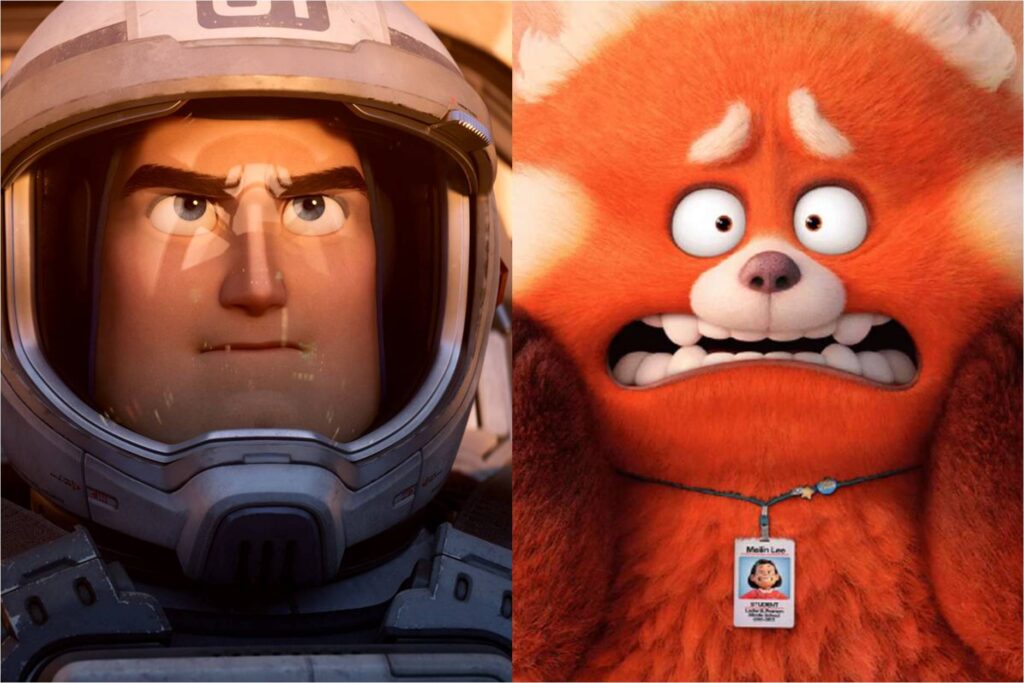
In 2013, six days after the release of Monsters University, then-Pixar president Ed Catmull said in an interview that the animation juggernaut was newly committed to making an original picture every year, and to correspondingly limit its sequels to biennial productions. The announcement came in the wake of a widely perceived (if relative) creative drought for the studio, whose prior two movies, the misbegotten Cars 2 and the pleasant but familiar Brave, hadn’t lived up to the legacy of greatness established during its inaugural 15-year run—a run that concluded, ironically, with a sequel (the stupendous Toy Story 3). Mathematically speaking, Pixar didn’t quite make good on its promise—of the next 10 films it released, four were sequels—but the wunderkinds of computer-drawn fantasy have for the most part threaded a delicate needle over the past decade, simultaneously making risky original movies and cranking out commercially safe follow-ups.
This “original vs. sequel” framing perpetuates a false dichotomy—the idea that original films are inherently works of boisterous ingenuity, whereas sequels are lazy and mercenary. (For this writer’s money, the existential crises conjured in Toy Story 4 are far more thought-provoking than the recognizable road-trip hijinks of Onward.) Still, in an era where Pixar’s parent company Disney continues to gobble up market share thanks to its ownership of mighty franchises like Star Wars and the Marvel Cinematic Universe—and where the apparent antidote to Mouse-House supremacy involves a competitor sequelizing a hit from 1986—it’s understandable for critics to prize the production of original screenplays as an independent good. Given that, it’s fascinating to examine Pixar’s two releases in 2022: one a science-fiction adventure that spins off from beloved intellectual property, the other a tender coming-of-age story whose only tie to the Pixar brand is its embrace of innovative storytelling.
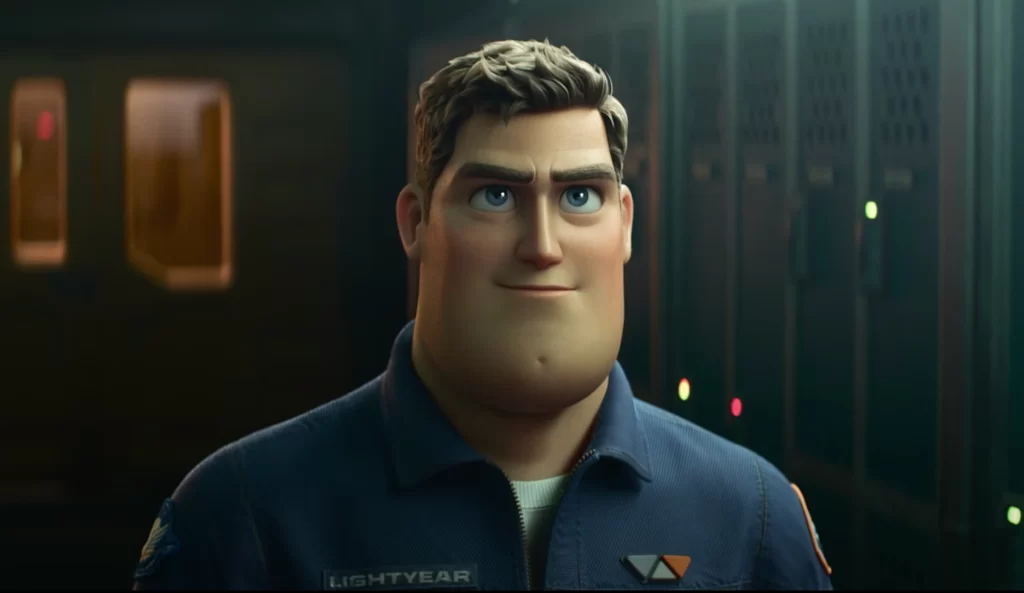
Technically, Lightyear is neither a sequel nor an original. It exists instead in a curious netherworld, banking on its audience’s foreknowledge of its title character while attempting to develop its own new mythology. Everyone remembers Buzz Lightyear, the square-jawed space ranger with the nifty gadgets who spoke in the confident rumble of Tim Allen and who was repeatedly told—by an increasingly exasperated Tom Hanks—that he was, in fact, a toy. As its heavily memed and faintly absurd title card reveals, Lightyear is in fact the (real) movie that inspired the manufacture of that (fictional) toy. This bit of narrative nonsense allows Pixar—and more specifically Angus MacLane, the film’s director who also wrote the screenplay with Jason Headley—to pepper the picture with sly and stale references to the Toy Story canon while otherwise crafting a science-fiction voyage that’s unbound to the earthly logic and metaphysical preoccupations of the studio’s first and most successful franchise.
At the risk of uttering faint praise, the result is less ungainly than you might expect. Yes, it’s a little weird to watch Buzz (now voiced by Chris Evans) wield his once-plastic weaponry to generate actual plasma bolts, and some of the callbacks—a line about crystallic fusion, a plea for an answer from Star Command, a suspicion that “You’re mocking me, aren’t you?”—are as likely to produce grimaces of regret as smiles of recognition. (The famous slogan “To infinity and beyond” has been repurposed, now a mantra of camaraderie rather than a preening declaration.) For the most part, though, Lightyear doesn’t feel overly beholden to its predecessors. If anything, its themes are, if not quite inverted from Buzz’s initial journey of self-discovery, at least redirected; whereas Toy Story found Buzz gradually reconciling with his own inhumanity and cosmic insignificance, here he must accept his vulnerability as he labors to save an entire colony of humans who depend on him.
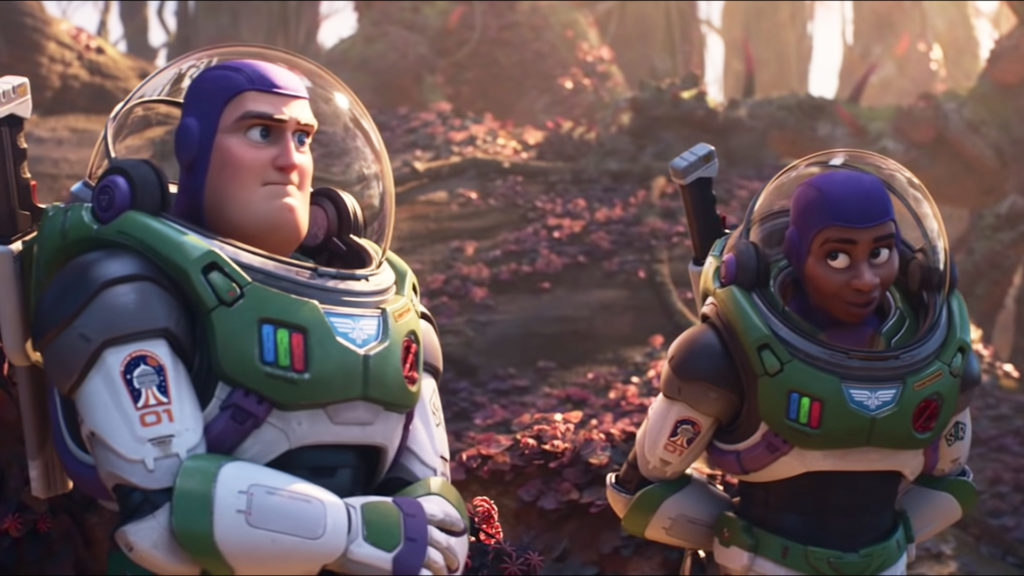
Lightyear is most enveloping in its first act, when Buzz and a compatriot, Alisha (Uzo Aduba), find themselves marooned on a hostile planet and must execute a complex set of maneuvers in order to regain access to hyperspace. Buzz repeatedly tries and fails to formulate the required fuel, but the details of his galactic derring-do aren’t important; what matters is that, thanks to the elasticity of the space-time continuum (and a conceit borrowed from Christopher Nolan’s Interstellar and Robert Zemeckis’ Contact), every brief test flight for him equates to four elapsed years on land, meaning Alisha and his other colleagues age rapidly as he darts among the stars. MacLane captures this asymmetrical process in a vigorous and powerful montage that recalls the classic opening of Pixar’s Up, silently chronicling the milestones in Alisha’s life—her marriage, her parenthood, her death—while Buzz fruitlessly goes it alone.
The remainder of Lightyear, which involves Buzz teaming up with a trio of misfits as they attempt to defeat the evil Emperor Zurg (remember him?), is playful, appealing, and pretty conventional. The secondary characters are likable enough, but their shadings—one has a phobia of outer space, another likes to blow shit up, a third is vaguely clueless—lack true definition. The obvious exception is Sox, the robotic cat who speaks in the soothing monotone of Good Dinosaur director Peter Sohn, and who combines scientific rigor with genuine tenderness; whether he’s incapacitating foes with hidden darts or analyzing data to the sounds of “beep boop” and “meow meow,” Sox continues the company’s recent tradition of feline excellence.
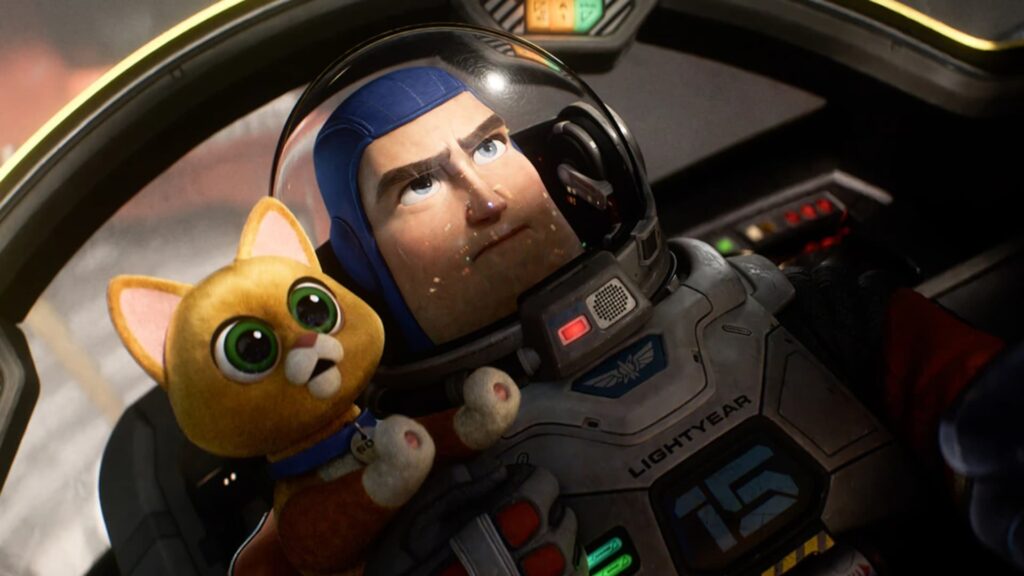
Sox is cute, and Lightyear, with its breezy pace and immaculate visuals, is an undeniably pleasant experience. What it lacks—what exiles it to that cheerful island of passable entertainment known as Lesser Pixar—is a true spark of creativity. It’s unfair to say that the film is a soulless cash grab, because its fusion of Toy Story tropes and new-age planet-trotting is too strange to be callously commercial. But what, exactly, is its animating principle? It possesses no invigorating ideas, no conceptual boldness, no mystical sense of wonder. It’s a perfectly decent children’s movie from a studio which made its bones by proving that animation could do far more than provide perfectly decent children’s movies.
One of the cleverer touches in Lightyear involves the futuristic composition of sandwiches, which reverses the typical structure and places one slice of bread between two slabs of meat. That’s different, but it’s the exception here rather than the rule; as a cinematic experience, Lightyear is certainly more nutritious than peanut butter and jelly, but no more exotic than ham and cheese wedged between two chunks of rye. Or to change the metaphor from food to aviation: Buzz routinely expresses contempt for autopilots, preferring to rely on his own human instincts, yet it’s the mechanical spirit of straight-line navigation that embodies his movie. Lightyear hits its beats and calibrates its instruments and stays steadily on target, but it never truly takes flight.
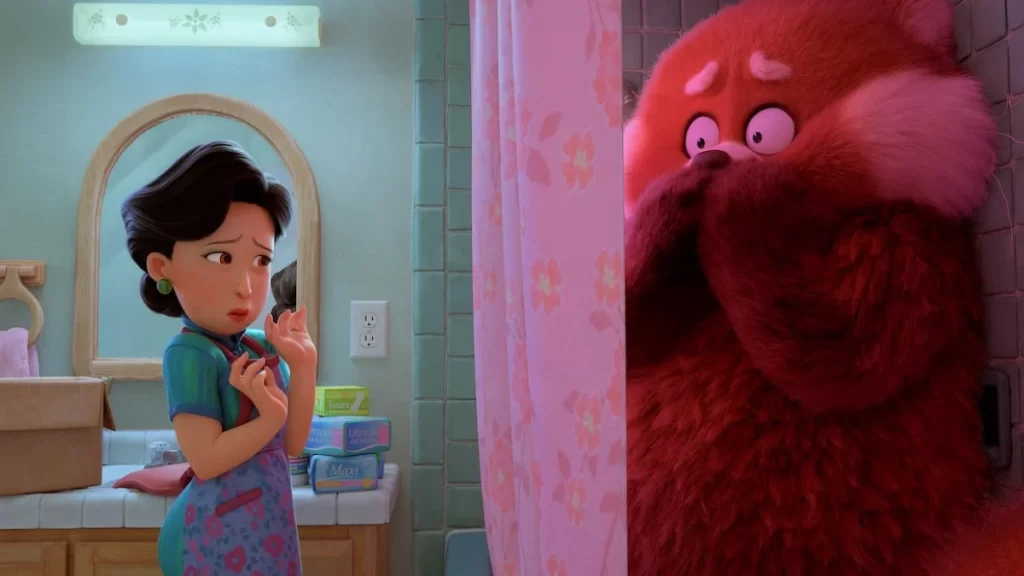
There are no spaceships in Pixar’s other 2022 release, but there are plenty of flights of fancy. Turning Red, which the studio unceremoniously dumped onto Disney+ back in March (Lightyear is the first broad theatrical run that a Pixar flick has enjoyed since the pandemic), is a nominally smaller and less extravagant production; it takes place in the decidedly human realm of Toronto, and aside from a gloriously lo-fi Tamagotchi, there isn’t a robot or alien in sight. Yet it’s a far more ambitious and imaginative work than Lightyear, infusing the classic coming-of-age picture with idiosyncrasy and wit. It’s precisely the kind of original movie Pixar routinely used to make, and is still making.
One special thing about Turning Red is that it doesn’t initially seem all that special; there are no talking cars or hulking superheroes or flying houses. Instead it centers on a girl who’s perfectly ordinary, though she’d surely chafe if you called her that. As vibrantly voiced by Rosalie Chiang and lovingly animated by Domee Shi (directing from a script she wrote with Julia Cho), 13-year-old Mei Lee is an academic overachiever and all-around go-getter, unapologetic in her nerdery and confident in her destiny of someday becoming U.N. Secretary General. Mae is exacting in her studies—when she erases a mistake on her math homework, she swipes the pencil shavings into a wastebasket with one swift stroke of a ruler—but her scholarly rigor is interrupted once puberty intrudes. That’s right, Turning Red is a film about menstruation—you know, that evolutionary process by which a girl wakes up one morning and discovers to her horror that she has suddenly transformed into a giant panda.
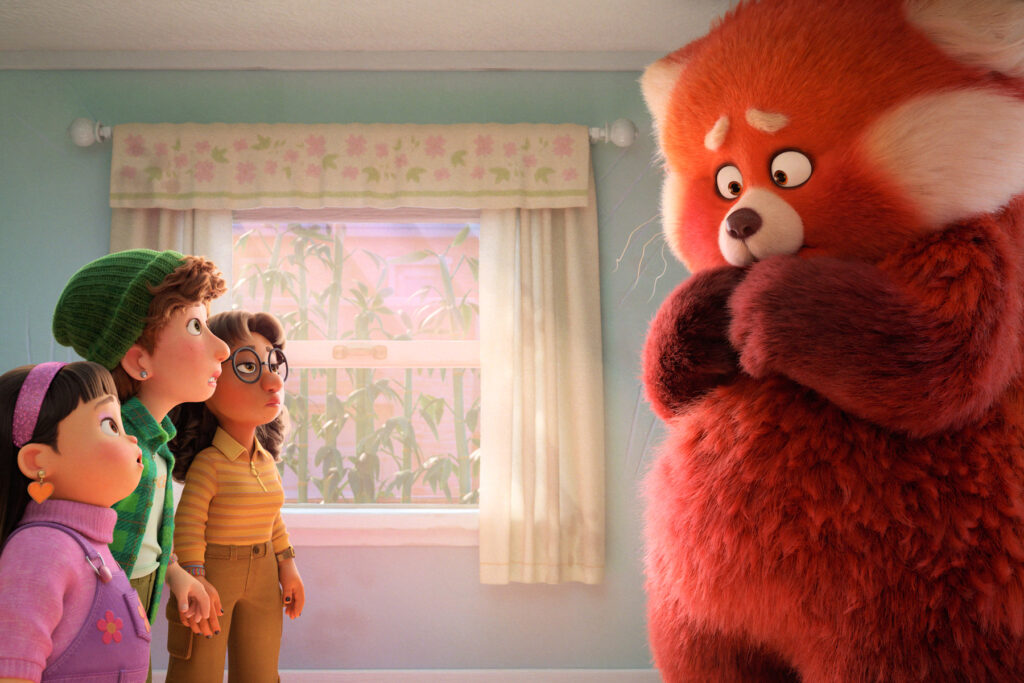
Wait, did I get my science wrong? Doesn’t matter. The allegory of Turning Red is too rich to be narrowed to a particular biological development, functioning instead as a broad study of child maturation and, more potently, a fraught depiction of mother-daughter conflict. Ming (Sandra Oh), the woman who rules the Lee household with a velvet glove and a spotless green blazer, is a dedicated and affectionate parent, showering Mei with praise and empowering her dreams. She is also something of a benevolent tyrant, inflexibly charting her daughter’s course through life. Mei is hardly oblivious to her mother’s rigidity but instead accepts it as the cost of a healthy childhood and promising future; observing that parents sacrifice everything for their kids, she rationalizes that “the least you can do in return is every single thing they ask.”
Does this dynamic remind you of anyone you know? Maybe, maybe not. (For my part, I hereby explicitly aver that I in no way sensed a vicarious kinship to any of the characters, not remotely, not at all.) One gratifying feature of Turning Red is that it’s thoroughly steeped in Asian culture, with detailed iconography—food, temples, mythical lore—that enriches its specificity. This shouldn’t be viewed as restricting its appeal but broadening it, inviting audiences to immerse themselves in a particular world while still connecting to the characters’ universal struggles.
Which are painful, yes, and also hilarious. Shi generates considerable comic mileage from her body-morphing premise, eagerly blowing up familiar tween feelings—confusion, lust, humiliation—to giant-panda size. Yet the movie never panders or condescends, instead acquiring a fine-grained texture—both visually and thematically. “You’re so fluffy!” one of Mei’s friends exclaims upon discovering her in her new animal guise. (That her pals embrace her drastic transformation with no hesitation is a heartwarming touch; among other things, the film operates as a moving paean to the solidarity of female friendship.) She’s right. We’ve long since passed the point where Pixar’s technique can be described as breathtaking, but the granularity of the animation here is nonetheless remarkable; Mei’s panda fur ripples with astonishing sensitivity that’s matched by her deeply expressive eyes, while you can practically smell the dumplings that her father plops onto a tray.
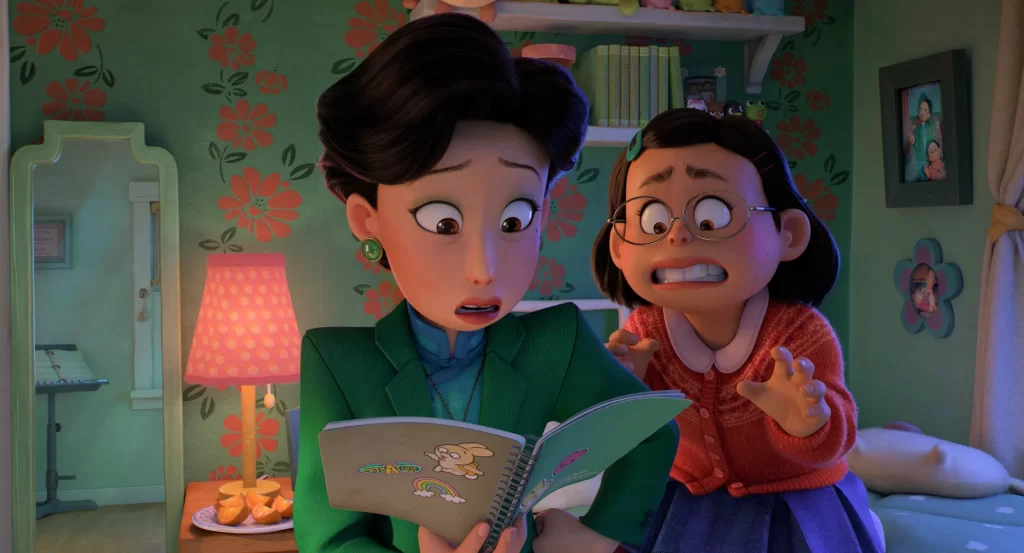
But while Turning Red is consistently amusing and occasionally hysterical (a throwaway moment when Mei’s beastly form lets slip a helpless “Awooga!” is to be forever cherished), its heart—the hurricane of emotion that swirls between Mei and Ming—is no laughing matter. Viewed from an unflattering perspective, the film’s platitudes—accept yourself for who you are, be honest with your friends, support your family—could be deemed proverbial, even trite. Yet the movie’s characters are so sharply drawn, and its dilemmas so decisively sketched, that it easily transcends its traditional underpinnings. The sequence in which Mei, pressed by relatives to discard her newfound identity, experiences a rush of happy memories from her brief time as a panda soars with genuine elation, while a late scene where she connects with an alternate version of her mother in an ethereal bamboo forest glows with unvarnished sincerity. (If the line “My panda, my choice” is somewhat on the nose, I am willing to forgive that bluntness given the current political climate.)
Turning Red isn’t a masterpiece. Its overall plot, in which Mei exploits her zoological gifts in order to earn money and attend a boy-band concert, is a tad contrived, while a climactic action sequence relies too heavily on sheer size. But its warmth is irresistible, and it possesses the transportive sense of freshness—the sensation that you’re watching an exciting new cinematic idea take wing—that Lightyear lacks. Not every original Pixar production is a great movie. But 27 years into its reign, there is still something uniquely great about a new Pixar original.
Lightyear grade: B-
Turning Red grade: B+
Jeremy Beck is the editor-in-chief of MovieManifesto. He watches more movies and television than he probably should.
